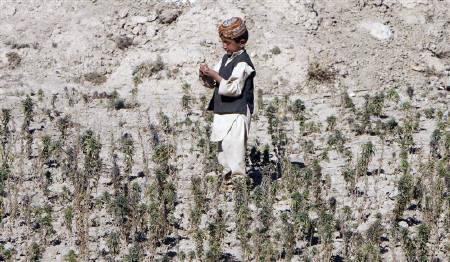Reuters, March 31, 2010
Afghanistan world’s top cannabis source - U.N.
...with more than two-thirds (67 percent) of cannabis farmers also growing opium
By Jonathon Burch

Between 10,000 and 24,000 hectares of cannabis are grown every year in Afghanistan, with major cultivation in 17 out 34 provinces, the U.N. drug agency (UNODC) said in its first report on cannabis production in Afghanistan.
Long the world's largest producer of opium, the raw ingredient of heroin, Afghanistan has now become the top supplier of cannabis, with large-scale cultivation in half of its provinces, the United Nations said on Wednesday.
Between 10,000 and 24,000 hectares of cannabis are grown every year in Afghanistan, with major cultivation in 17 out 34 provinces, the U.N. drug agency (UNODC) said in its first report on cannabis production in Afghanistan.
While some countries grow cannabis on more land, Afghanistan's robust crop yields -- 145 kg of resin per hectare compared to around 40 kg per hectare in Morocco -- make it the world's largest producer, estimated at 1,500-3,500 tonnes a year.
"This report shows that Afghanistan's drug problem is even more complex than just the opium trade," said Antonio Maria Costa, head of UNODC in the report.
"Reducing Afghanistan's cannabis supply should be dealt with more seriously, as part of the national drug control strategy."
For years Afghanistan has been the world's largest producer of opium, a paste extracted from poppies and processed into heroin. While land cultivated with poppies fell by 22 percent last year, record yields meant production fell only 10 percent.
The illegal opium trade is said to fuel the insurgency in Afghanistan with the Taliban siphoning off millions of dollars from the trade by imposing taxes on farmers and smugglers in return for ensuring safe passage of the drug.
"Like opium, cannabis cultivation, production and trafficking are taxed by those who control the territory, providing an additional source of revenue for insurgents," the report said.
As with opium, most cannabis cultivation takes place in the south of the country where the insurgency is strongest, UNODC said, with more than two-thirds (67 percent) of cannabis farmers also growing opium.
One of the main reasons cannabis is so widely grown, UNODC said, is because of its low labour costs and high returns. Three times cheaper to cultivate than opium, the net income from a hectare of cannabis is $3,341 compared to $2,005 for opium.
While cannabis production in 2009 was valued at an estimated $39-94 million, this is only about 10-20 percent of the total farm-gate value of Afghanistan's opium production, because so much more opium is grown.
While some of the cannabis is consumed within Afghanistan, most of the drug is smuggled abroad following the same routes as opium, UNODC said. In 2008, 245,000 kg of cannabis was seized in southern Kandahar near to the border with Pakistan.
"As with opium, the bottom line is to improve security and development in drug-producing regions in order to wean farmers off illicit crops and into sustainable, licit livelihoods, and to deny insurgents another source of illicit income," Costa said.
(Editing by Peter Graff)
Characters Count: 3695
